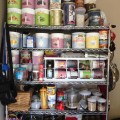 Building a home store has more advantages than you can imagine. It’s a good concept, but certainly not new. We are simply re-visiting ways our ancestors survived through droughts, winter storms and other severe weather. Most of our parents or grandparents had root cellars or basements and would can foods to last them through the winter months. It was vital to their survival to safely preserve and store food during the summer when it was abundant. They didn’t have convenience foods and grocery stores to buy pre-packaged meals if their own supplies ran out. They had to be diligent in food preservation, farming and complete self-reliance. And basically, that’s what many people today are trying to get back to.
Building a home store has more advantages than you can imagine. It’s a good concept, but certainly not new. We are simply re-visiting ways our ancestors survived through droughts, winter storms and other severe weather. Most of our parents or grandparents had root cellars or basements and would can foods to last them through the winter months. It was vital to their survival to safely preserve and store food during the summer when it was abundant. They didn’t have convenience foods and grocery stores to buy pre-packaged meals if their own supplies ran out. They had to be diligent in food preservation, farming and complete self-reliance. And basically, that’s what many people today are trying to get back to.
Most Americans have never seen our grocery supply interrupted except community-wide during major storms when shelves are stripped in less than 3 hours. We have never faced an economic and financial collapse of the government, nor lived through a depression. But in recent years we have seen how close we are to a collapse and how fragile our food and fuel supply is. It has drawn a certain kind of American to re-visit how our parents or grandparents lived and are trying to emulate it as best we can.
 As with any significant lifestyle change, there are certain start-up costs. However, in my own experience, I was able to recoup those costs and was quickly began seeing my grocery bill go down. Some of your start up costs is as follows:
As with any significant lifestyle change, there are certain start-up costs. However, in my own experience, I was able to recoup those costs and was quickly began seeing my grocery bill go down. Some of your start up costs is as follows:
1) Purchase of Freeze-Dried and powdered foods that allow for long-term shelf-stability. You will begin to make your own spice mixes and blends, box dinners, powdered drinks, breads and more.
2) Purchasing Canning Equipment & Supplies
- Quality Pressure Canner ~ The American Canner is the arguably the best on the market. It is metal on metal without the rubber ring which can eventually fail. It’s more expensive, but will last generations. You can look for them at garage sales, Craigslist and eBay.
- Water Bath Canner ~ This is an inexpensive purchase. I got my canner at Wal-Mart for around $20. Subsequently, I purchased a Ball-brand plastic basket that easily fits into an average size stockpot. It’s perfect for small batches of food. It holds up to 3 quart jars. I use it often for small batches of jellies and jams.
- Canning jars and lids ~ While many supplies like you see in kits are very nice to have, you can get by with only a jar lifter tool. The very best prices to get these types of supplies is at seasons end in the late fall. Also, always look at stores like Goodwill or Salvation army. I find them on Craigslist and at garage and estate sales. Normal retail prices vary on size of jars but full retail runs between $9-$12 per case.
- Grain Mill ~ I purchased two inexpensive mills but quickly realized that they would be inadequate for my needs. I want to grind my flour in large quantities and those of different sizes from small Quinoas to corn and red beans. I researched it exhaustively. But I finally settled on the highly reviewed Country Living Grain Mill. Again, it’s one of the finer pieces of equipment and its’ cost is reflective of that. It was about $500. I wound up purchasing some accessories, which I wanted, but you can do without. It’s price is consistent with other mills of this caliber, and in some cases costs less than some. This grain mill will also be handed down from one generation to the next. It is a manual fly-wheel design that can be altered to be electric. I wanted one that did not rely on electricity. And it is 100% USA made.
- Dehydrator ~ Here, too I began on the cheap. And I got what I paid for. I purchased a used round dehydrator I bought on eBay. I didn’t know enough about dehydrating at the time to realize it was an old model and incredibly inefficient for the volume of food I was dehydrating. Newer versions of the round ones have more features and I see them used a lot on the You Tube videos I watch. But it worked well enough to make me realize that dehydrating was going to save me a lot of money, especially from what I was spending on commercially processed dehydrated food. I eventually moved up to buying the very best residential dehydrator on the market. That is not just my opinion, you can Google reviews and come to the same conclusion.
You also will need to learn new prepping skills;
- Gardening ~ Using heirloom seeds will allow you to harvest seeds so you will never need to purchase them again. You can find endless blogs, FB Pages and articles to teach you ways and what to grow. Even if you are in an apartment or small space, you can still grow food using raised beds or various containers. Things like herbs can be grown on your windowsills indoors.
- Canning ~ I found the first steps to learning to can were intimidating. I had never canned before or been around a material figure who ever did it in my presence. But canning has come a very long way. It’s not to be feared. It’s actually very easy, whether you pressure or water bath can. Just follow the strict guidelines, watch demonstrations on You Tube and contact your local Extension office who often hold classes to teach you.
- Dehydrating ~ Basically, dehydrating is simply cutting food into small slices or pieces and putting in the dehydrator. Sometimes however, there are one or two steps to take before your food goes into the dehydrator. Again, the internet is an vast world of information at your fingertips that will give you the particulars to being successful in drying your own food.
- Cooking with food storage ~ This goes to my point of making some minor adjustments in preparations, but cooking much the same as you already do.
I was buying dry foods from companies we all see advertised all over prepper pages, blogs and other survivalist sites. I purchased all those name brands, but didn’t know to do anything with them except stack them neatly in my long-term storage. Only when I started buying THRIVE food from ShelfReliance did I start to understand that I was really wasting money by continuing to store their food while going to the grocery store and spending outrageous prices for packaged foods when I now had the same ingredients in my home that commercial processors use to make dry mixes and entree’s, but without the additives. My THRIVE consultant and ShelfReliance’s website taught me how to save money by actually using their food in my “conventional” recipes.
They also have a program called The Q. This is where I was able to set a budget for buying Freeze-Dried and powdered food and ingredients. I then went into start building my home store. I went online and started shopping and picking out the products I needed in my store. Some of the powdered foods and staples I put on my Q were these:
- Butter
- Shortening
- Honey
- Instant & Powdered Milk
- Cheese Powder
- Eggs
- Sour Cream
- Chicken & Beef Bouillon
Some of the Freeze-Dried foods in my Q were these:
- Ground Beef
- Chicken
- Sausage
- Various Fruits
- Ham
- Instant Beans and Lentils
- Vegetables (Example)
- Corn
- Green Beans
- Peas
- Onions
- Green/Red Peppers
- Carrots
- Broccoli
- Spinach
I set a budget of $200 per month based on my overall grocery budget. You can go as low as $50. Each month, I received an automatic shipment of foods from my Q. But I made sure I checked their sales for the month to be sure to replace what I could wait on with what I needed that was on sale. Within a few months, my home was bursting with #10 cans of healthy and delicious food.
I also decided to become a consultant for THRIVE last year which helps to reduce my expenses even more as I pay “employee” prices and earn credit and a small income which I use toward food and emergency supplies. I have been able to buy the sun oven and rocket stove without actually breaking into my own money.
But THRIVE didn’t meet all my needs and I eventually learned of other resources to help my food budget. The best one was my local LDS Cannery through the Latter Day Saints Church. Now I buy my powdered milk, sugar, potato flakes and drink mixes through them. Their prices can’t be beat. But like with any company or organization, they have limits, too. They don’t carry Freeze-Dried foods and no meat. They offer only the very basic staples.
I’m now down to one grocery store trip a month. And when I go, I’m very diligent in making a list and sticking to it. I search for coupons and go to bulk stores to make the most of my budget. Even when I don’t “need” frozen vegetables, if they are on sale I still buy them and immediately put them into my dehydrator and keep them in my pantry. My food costs have gone down significantly and I rarely run out of anything. And if I do, it’s just a matter of taking a moment to pull cans off my shelf and making another batch.
When it comes to milk, I have two little ones, 5 and 3 years old. We go through a lot of instant milk. I found it cheaper to make drinking milk from storage, even though it is more expensive per serving than fresh. My reasoning is that to stop by the grocery store for a gallon of milk and even a loaf of bread always winds up being an armload (or more) of impulse purchases. A quick stop to the store would always wind up costing $25 or even $100! Impulse buys are killers of your tight budget.
 But with the political upheaval in D.C., I decided to take my regular Q deliveries of instant milk and stock them away. If milk prices skyrocket as is predicted, I will pull them out. But in the meantime, I will save my reserves until I need them more. As long as prices remain stable, it’s wiser for me to buy fresh and save the instant.
But with the political upheaval in D.C., I decided to take my regular Q deliveries of instant milk and stock them away. If milk prices skyrocket as is predicted, I will pull them out. But in the meantime, I will save my reserves until I need them more. As long as prices remain stable, it’s wiser for me to buy fresh and save the instant.
I have several recipes posted on this blog. These are mostly intended to use food storage. You will find both mixes and meals. I have many more recipes to share and post. I will make a concerted effort to post more.
I grind my own flour, buy sugar in bulk to use in my kitchen pantry (different than my #10 cans in long-term storage), buy legumes and beans in large quantities and can or package them myself.
There are many families out there who also have home stores. They may have built theirs differently, but this is how I built mine. I made many mistakes along the way that were costly that I would have rather avoided, but were all good lessons.

Click here to visit my THRIVE Store
But having your own store will require a different way of preparing your food. Rehydrating dry food will require adjustments to liquids and a certain level of pre-planning to allow for the rehydration process. It’s not like opening a can of corn and throwing it into a microwave. I actually have very few “cans” of food on my shelves. Not the kind of canned vegetables you see in about every kitchen across the country. My cans are the big #10 size cans and the food inside is dry. I have canning jars filled with fruit and vegetables I dehydrate myself. I have canning jars filling my shelves with last summers peaches, beans, peas and pickles. I even can a lot of meat. I find I actually spend less time preparing meals because much of the work has already been done.
Below are either exactly or comparable with the equipment I have in my home. It’s a lot of equipment and collectively it cost a lot of money. But I did it one step at a time. It took me about a year when my plan got on track.
Read Full Post »
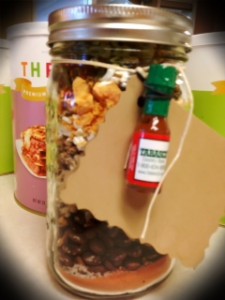 I am married to a Texan. A few things I learned to cook when we were married was bbq brisket, bbq beans and chili. He really is a chili snob. So I felt really challenged when I set out to make a dry version from the ingredients we have in our food storage. After all, preparing for hard times is being affected as little as possible. Having your favorite foods will make the hard times much easier and healthier to face. It took a few tweaks, but I put a recipe together that he is very happy with and is regularly rotating into my menu.
I am married to a Texan. A few things I learned to cook when we were married was bbq brisket, bbq beans and chili. He really is a chili snob. So I felt really challenged when I set out to make a dry version from the ingredients we have in our food storage. After all, preparing for hard times is being affected as little as possible. Having your favorite foods will make the hard times much easier and healthier to face. It took a few tweaks, but I put a recipe together that he is very happy with and is regularly rotating into my menu.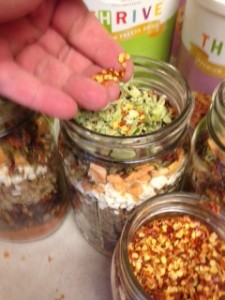

 Like me, so many of us are diligently planning our spring gardens. We start our pen-to-paper plans, gather supplies to start our precious seeds, and wait for the weather to turn so we might start working and preparing our beds. But in this idle time we have waiting, you really should be considering inventorying your canning supplies and planning your crop based on your families need.
Like me, so many of us are diligently planning our spring gardens. We start our pen-to-paper plans, gather supplies to start our precious seeds, and wait for the weather to turn so we might start working and preparing our beds. But in this idle time we have waiting, you really should be considering inventorying your canning supplies and planning your crop based on your families need.


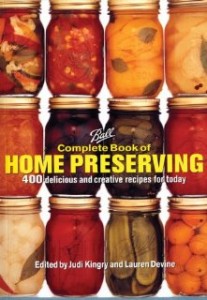
 I recently posted the recipe for the sourdough starter I made. It turned out very, very good. So of course, I needed to jump right in and start making sourdough bread. I searched high and low and happened across a recipe to make it in my
I recently posted the recipe for the sourdough starter I made. It turned out very, very good. So of course, I needed to jump right in and start making sourdough bread. I searched high and low and happened across a recipe to make it in my 



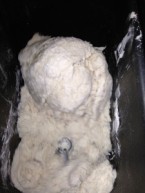

 One of my favorite books for pioneer recipes is
One of my favorite books for pioneer recipes is 
 How many dishes do you make that calls for teriyaki sauce? If you don’t already use this delicious, sweet and spicy condiment, you should look at your chicken or beef at a different angle. This sauce is one of my families favorites. This is a great addition to your home store.
How many dishes do you make that calls for teriyaki sauce? If you don’t already use this delicious, sweet and spicy condiment, you should look at your chicken or beef at a different angle. This sauce is one of my families favorites. This is a great addition to your home store.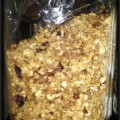 Building up my home store saves me money, time and allows me to control the ingredients my family is exposed to. With a 3 year old and 5 year old, cereal is a given. But who really wants to pour unhealthy, refined sugary food out for them? Not this nana! Here is a delicious and healthy alternative that my children love.
Building up my home store saves me money, time and allows me to control the ingredients my family is exposed to. With a 3 year old and 5 year old, cereal is a given. But who really wants to pour unhealthy, refined sugary food out for them? Not this nana! Here is a delicious and healthy alternative that my children love.
 Building a home store has more advantages than you can imagine. It’s a good concept, but certainly not new. We are simply re-visiting ways our ancestors survived through droughts, winter storms and other severe weather. Most of our parents or grandparents had root cellars or basements and would can foods to last them through the winter months. It was vital to their survival to safely preserve and store food during the summer when it was abundant. They didn’t have convenience foods and grocery stores to buy pre-packaged meals if their own supplies ran out. They had to be diligent in food preservation, farming and complete self-reliance. And basically, that’s what many people today are trying to get back to.
Building a home store has more advantages than you can imagine. It’s a good concept, but certainly not new. We are simply re-visiting ways our ancestors survived through droughts, winter storms and other severe weather. Most of our parents or grandparents had root cellars or basements and would can foods to last them through the winter months. It was vital to their survival to safely preserve and store food during the summer when it was abundant. They didn’t have convenience foods and grocery stores to buy pre-packaged meals if their own supplies ran out. They had to be diligent in food preservation, farming and complete self-reliance. And basically, that’s what many people today are trying to get back to. As with any significant lifestyle change, there are certain start-up costs. However, in my own experience, I was able to recoup those costs and was quickly began seeing my grocery bill go down. Some of your start up costs is as follows:
As with any significant lifestyle change, there are certain start-up costs. However, in my own experience, I was able to recoup those costs and was quickly began seeing my grocery bill go down. Some of your start up costs is as follows:
 But with the political upheaval in D.C., I decided to take my regular Q deliveries of instant milk and stock them away. If milk prices skyrocket as is predicted, I will pull them out. But in the meantime, I will save my reserves until I need them more. As long as prices remain stable, it’s wiser for me to buy fresh and save the instant.
But with the political upheaval in D.C., I decided to take my regular Q deliveries of instant milk and stock them away. If milk prices skyrocket as is predicted, I will pull them out. But in the meantime, I will save my reserves until I need them more. As long as prices remain stable, it’s wiser for me to buy fresh and save the instant.